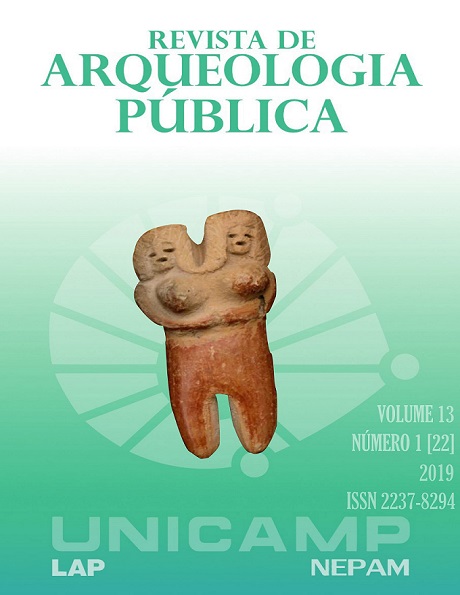Resumen
El presente artículo tiene como objetivo realizar un análisis acerca del modoDiscovery Tour, desarrollado por Ubisoft Montreal para el juegoAssassin's Creed Origins.El Discovery Toures propuesto por los desarrolladores como una herramienta "puramente educativa", entendida como un "Museo Virtual" que ayuda a los alumnos en la comprensión del pasado a través delTourguiados y la exploración de sitios históricos. En este estudio se discute la censura realizada a las estatuas del Mundo Grecorromano, una vez que éstas aparecen en este -y sólo en este -modo de juego con pechos y genitales cubiertos por conchas, con el fin de plantear preguntas acerca de la enseñanza y la mirada sexualizada sobre el pasado.
Citas
ALVES, Luciana; BIANCHIN, Maysa. O Jogo como Recurso de Aprendizagem. Revista Psicopedagogia, São Paulo, v. 27, n. 83, p. 282-287, 2010.
BARBIERI, Loris; BRUNO, Fabio; MUZZUPAPPA, Maurizio. Virtual museum system evaluation through user studies. Journal of Cultural Heritage, v. 26, p. 101–108. 2017.
BEIER-DE HAAN, Rosmarie. Re-Staging Histories and Identities. In: Macdonald, Sharon. (Ed.) A Companion to Museum Studies. Oxford: Blackwell Publishing, p. 186-198, 2006.
BERRY, David. Understanding Digital Humanities. New York: Palgrave Macmillan, 2012.
BOARDMAN, John. Greek Sculpture: The Archaic Period. London: Thames and Hudson, 1996.
BOARDMAN, John. Greek Sculpture: The Classical Period. London: Thames and Hudson, 1995.
BOARDMAN, John. Greek Sculpture. The Late Classical Period. London: Thames and Hudson, 1995.
BRUNO, Cristina. Museus, identidades e patrimônio cultural. Revista do Museu de Arqueologia e Etnologia. Suplemento 7. São Paulo, 2008, p. 145-151.
BUTLER, Judith. Gender Trouble. New York; London: Routledge. 1990.
CLARK, Jeffrey. The Fallacy of Reconstruction In: FORTE, Maurizio. (Ed.). CyberArchaeology. Oxford: Archaeopress, BAR v. 2177, p. 63-74, 2010.
COVER, Rob. The Naked Subject, Context and Sexualization in Contemporary Culture. In: Body & Society, v. 9. n. 3, London; Thousand Oaks; New Dehli: Sage Publications, 2003, p. 53-71.
FOUCAULT, Michel. História da Sexualidade: O Cuidado de Si. v 3. Rio de Janeiro: Edições Graal, 1985.
INSOLL, Timothy. Introduction: configuring identities in archaeology. In: INSOLL, Timothy (ed.). The Archaeology of Identities: A Reader. London; New York: Routledge, 2007, p. 1-18.
MCCALL, Jeremiah. Teaching History with Digital Historical Games: An Introduction to the Field and Best Practices. In: Sage, v. 47, n. 4, p. 1-26, 2016.
MCMICHAEL, Andrew. PC Games and the Teaching of History. In: The History Teacher, v. 40, n. 2, p. 203-218, 2007.
MOSCHINI, Rosanita; CAIERÃO, Iara. O Brincar na Clínica Psicopedagógica. Revista Psicopedagogia, São Paulo, v. 32, n. 99, p. 361-365, 2015.
MPAA. Classification and Rating Rules. Sherman Oaks & Washington: 2010.
PIVEC, Maja; KRONBERGER, Anika. Virtual Museum: Playful Visitor Experience in the Real and Virtual World. 8th International Conference on Games and Virtual Worlds for Serious Applications (VS-GAMES), 2016. p. 1-4.
SANTOS, Dominique. De tablet para tablet ‐ novas ferramentas para a pesquisa e o ensino
da história das culturas cuneiformes na era digital. Revista Tempo e Argumento, Florianópolis, v. 6, n. 12, p. 212 ‐ 241, mai./ago. 2014.
SCHREIBMAN, Susan; SIEMENS, Raymond; UNSWORTH, John (eds.). A companion to Digital Humanities. Malden; Oxford; Victoria: Blackwell Publishing, 2004.
SCHWEIBENZ, Werner. The Development of Virtual Museums. ICOM News, v. 57, n. 3, p. 3. 2004.
SHANKS, Michael; TILLEY, Christopher. Reconstructing Archaeology: theory and practice. Cambridge, Cambridge University Press, 1992.
SMITH, Roland. Hellenistic Sculpture. London: Thames & Hudson World of Art, 2005.
TAHINCI, Anna. Removing the feags leaf: todays Nudity in the American Public Eye. Sculpture Review. v. 57, n. 2 p. 16-23, 2008.
VOUT, Caroline. Sex on Show: Seeing the Erotic in Greece and Rome. London: British Museum Press, 2013.
The Guardian. Disponível em: https://www.theguardian.com/technology/2017/oct/05/assassins-creed-originsrecreated-ancient-egypt-ubisoft. Acesso em: 25. 04. 2019.
ICOM - International Council of Museums. Disponível em: https://icom.museum/en/. Acesso em: 16. 02. 2019.
Ubisoft. Disponível em: https://support.ubi.com/en-gb/Faqs/000031846/Discovery-Tour-Mode-of-Assassins-Creed-Origins-ACO. Acesso em: 25. 04. 2019.
PC Games News (PCGamesN). Disponível em: https://www.pcgamesn.com/assassins-creed-origins/assassins-creed-originsdiscovery-tour-nude-statues-censorship. Acesso em: 20. 02. 2019.
Schnapp, J. and Presner, P. Digital Humanities Manifesto 2.0., 2009.
Smithsonian. Disponível em: https://www.smithsonianmag.com/arts-culture/true-colors17888/?c=y&page=3, Acesso em: 26. 02. 2019.
A Revista Arqueologia Pública utiliza a licença do Creative Commons (CC), preservando assim, a integridade dos artigos em ambiente de acesso aberto.


